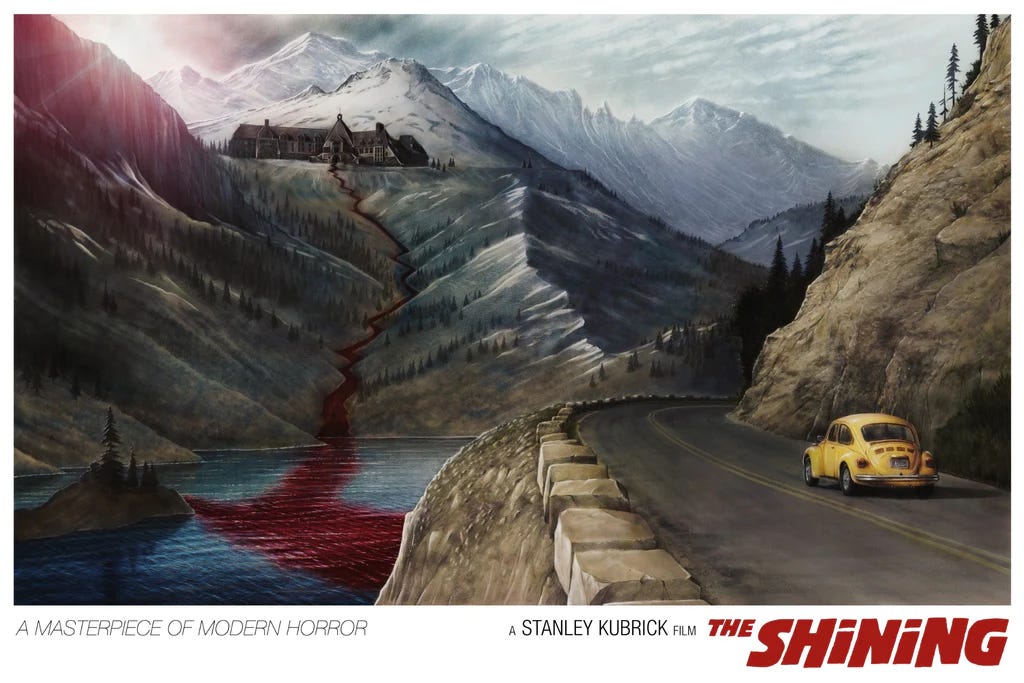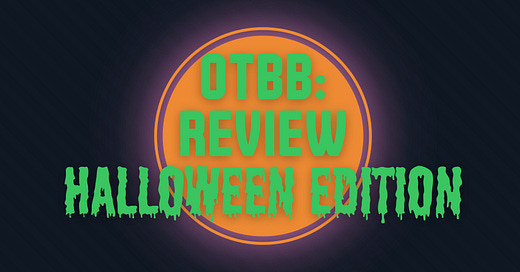The Shining Review
He came as the caretaker, but this hotel had its own guardians - who'd been there a long time.
Director: Stanley Kubrick
Producer: Stanley Kubrick
Writers: Stanley Kubrick, Diane Johnson
Editor: Ray Lovejoy
Cinematographer: John Alcott
Production Design: Roy Walker
Composer: Wendy Carlos, Rachel Elkind
Costume Design: Milena Canonero
Cast: Jack Nicholson, Shelley Duvall, Scatman Crothers, Danny Lloyd
Runtime: 144 minutes
Country of Origin: UK, USA
US Release: May 23, 1980 | Theatrical
For the majority of horror films I’ve watched, after the first viewing the horror aspect leaves and what remains is a fascination of how it was made, or just an enjoyment of the vibes of the film. The Shining is one of the few that still, after many viewings, unnerves and scares me.
The terror is real.
The basic idea is prime for a good scary story—Jack Torrance (Jack Nicholson) takes a job as the off-season caretaker of The Overlook Hotel in Colorado, where he and his family, wife Wendy (Shelley Duval) and son Danny (Danny Lloyd), will live in isolation.
During the interview for this job, we learn with Jack about a previous caretaker who went mad from the isolation and murdered his wife and two daughters. Jack response to this revelation? “Well, you can rest assured, Mr. Ullman, that's not going to happen with me. And as far as my wife is concerned, I'm sure she'll be absolutely fascinated when l tell her. She's a confirmed ghost story and horror film addict.”
Sure, Jack.
We are also introduced to the idea of magic being present in this world via the hotel cook, Dick Halloran (Scatman Crothers), talking with Danny about their shared ability to “shine.” This ability is what allows the creepiest imagery of the movie to exist—the twin girls in the hallway, the blood elevator, and the woman in the bathtub, just to name a few.

Yes, the imagery is unnerving and spooky, with the set design and art design perfectly fitting the unease of the narrative. However, what rattles me more and more upon each revisit is the character of Jack.
He is a mediocre man, who is so bothered by his limitations that he inflicts violence on those around him. It’s such a grounded characterization that I genuinely feel frightened by how not far removed from reality it is—the timelessness of the violence that the mediocre man’s burden has wreaked upon the world.
Maybe that’s giving Kubrick too much credit. Which he has received plenty of, some earned and some given by over-enthusiastic Room 237 truthers.
Back to the actual film.
It’s a slow-burning, long film, but it earns and justifies that length. The characters are meant to feel the slow pass of time, and that adds to their encroaching madness, well Jack’s at least.
I also was very affected by the score and sound design on this watch. The score is fleeting, as most of the music isn’t original. Béla Bartók’s Music for Strings, Percussion and Celeste is prominently featured throughout. The part I personally felt best utilized this was the scene where Jack promises Danny he would never hurt him or Wendy, and that he wishes they could stay in the hotel forever. Terrifying.
Another sound aspect that really struck me this time around were the sudden explosions and abrupt removal of sound while Danny bikes around the hotel. It felt like it was part of the score—a dissonant, experimental, abstract score.
The highest praise I give to this movie is its brilliance being compounded by coming back to it. Not many films have that ability: most will just be equally good, and a rare few will be diminished.

I feel it’s important to talk about the making of this movie as well. It’s an infamous one.
Kubrick is a director I have a love/hate relationship with. The art he has left behind is very evocative and some of the best in the history of film. However, he was a demanding, egotistical man, who created harsh work environments. I don’t believe any work of art is worth the abuse of other people, and I also believe this movie is excellent. This is a struggle with a number of films and other works of art that I will wrestle with over my entire life.
The shoot for this movie was 13 months. Even accounting for the month-long shooting halt because Nicholson injured his back, that’s a lot to ask of the people making this. For reference, an average a shoot will take 1–3 months, depending on a variety of things.
Add to it that Kubrick had a notoriety for reshooting scenes. This movie has earned a Guinness World Record for most retakes on one scene with dialogue. That scene? The baseball bat scene with Duvall and Nicholson.
Purportedly, this was by design to unnerve Duvall and maker her emotions real. Regardless of if it was a deliberate choice to break her down, or a side effect of his perfectionism while shooting, Duvall suffered. Which shouldn’t happen in a work environment, even if it’s for “the art.”
Scatman Crothers also had a hard time with the retakes—breaking into tears around 85 takes.
The other part of this is that Duvall and Crothers have said they liked making the movie, they just wouldn’t do it again. So, if the victims say it’s fine, how upset do we outsiders need to be. It’s a complicated feeling that I have no complete answer for, except that people shouldn’t be harmed in any way for a film.
I feel it’s important to note this type of behavior, and not have it forgotten just because the film is good.

Final Verdict
The Shining is a classic for a reason. In spite of the behind-the-scenes problems, the film is excellent. A rare example of a film that grows in esteem upon re-engagement, The Shining is a must-watch for horror fans, and a great entry point for those curious in engaging with film as an art form and not just as entertainment.
Thanks for reading. Til next time!
- Colton




